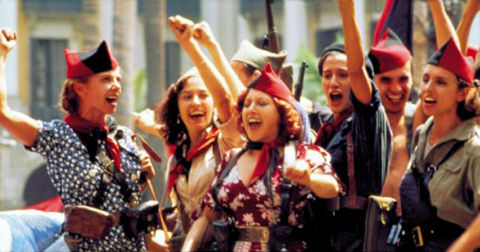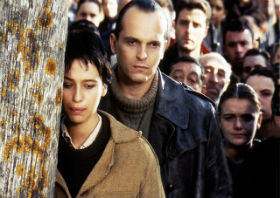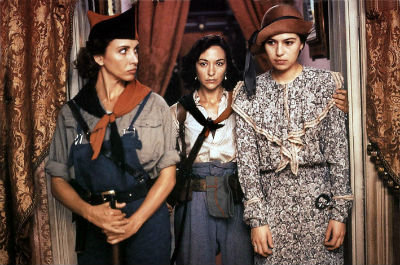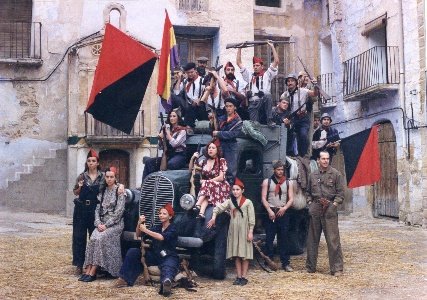
In some of the many interviews held
with you over the last few years, we usually asked you at the end
when the movie "Libertarias" would be finished. The film has
finally become a reality, right?
"Libertarias has finally arrived
indeed, and under very special circumstances -not as special as
most people expected, but they are nevertheless rather peculiar.
When work on the script began, the Berlin Wall was still standing
and the world was obviously more idealistic than at present. What I
don't know is to what extent upholding ideals and systems that
promised a better life has favored the film. I don't know if
the collapse of all that has been of any benefit to the film or if
it has been detrimental, but my intention has been to show such
ideals in their heyday, when Spain was the capital of the
world.
I think it important to discuss
this, not for abstract reasons of memory or because we are obliged
to repeat history, but in order to make up for past sins, so to
speak, although it could be quite the opposite. Because nothing is
for sure; in the civil war all manner of things went on. There was
cruelty, but also heroic moments, altruism, generosity and
selfishness. All sorts of things happened but, in retrospect, now
that so many years have elapsed, it might be appropriate to say
that what our parents and grandparents experienced, what they went
through, was a historic moment which we should perhaps envy. It was
an exceptional situation that no longer exists. In a certain way,
life now is more tranquil and we have what people call peace, but
it is a disquieting, awkward peace."

When and how did the idea of doing
the film originate?
"I think it was in 1976, before I
shot 'La muchacha de las bragas de oro' (The Girl with the Golden
Panties.) Possibly, when I filmed 'Cambio de sexo' (Sex Change),
work on the script had already started. I separated from my first
wife between "Cambio de sexo" and "La muchacha," and at the time I
used to write at home. As to supporting documentation for the film,
the person who was mainly in charge of it was José Luis (Guarner),
who had greater reading capacity and related skills, which doesn't
mean to say that others, including myself, weren't also involved.
Rabinad kept the books. Also, I am the least skilled of all at
handling documentation."
Have you downsized the script
much?
"Well, the original script was 240
pages long and I have eliminated several scenes. As to what I have
actually filmed, no, I haven't eliminated anything. In any case,
more than downsizing, I have reduced the footage. The only scene
that has really been deleted is a very burlesque one in which André
Malraux and Josep Tarradellas appear.
There is a marked synthetic
tendency in the film due to the fact that the script was very long.
So long that at one moment, although it was conceived as a film for
movie theaters, it might be used to make a television series.
However, the film isn't as long as I thought it would be. But I
must tell you that it was an obsession of mine during the shooting,
and when I went into the editing room I didn't take a pair of
scissors with me but rather an axe.

I intended to cut out everything
that seemed to be even slightly unnecessary. After the first edit,
the film was 115 minutes long. Subsequently, after an extra week of
additional shooting the final running time was 125 minutes.
However, later on I restored some elements because I thought that I
had excessively become the guardian of the film's footage."
You take sides; your allegiance to
one of the two factions is obvious.
"Yes, it is very clear in the film.
Miguel Bosé once said something that is very noteworthy: I admit
that poor people can behave crazily at a given time, but in spite
of it all, they are right. Why? Because they are poor, and the
others are rich. Buñuel himself said it: poor people don't
necessarily have elegance on their side. That's a privilege
reserved for the wealthy who, because of their cultural heritage,
are just as guilty or even more. I know very well who the good guys
are and who the bad guys are. At any rate, there were guilty people
on one side and innocent people on the other. Besides, I was on the
side that lost. And as to the others…I find it extremely hard to
acknowledge a single virtue in them. Not even one."
The action scenes; the
assault on the nationalist positions, were they difficult to
film?
"Yes, that has been was of my
greatest challenges. I solved the problem by dealing with them as
if they were choreographic movements, by means of diagonals and
symmetrical axes. The battle worried me because inevitably, it had
to be filmed. Curiously, to a witness of the events, my brother
Palmiro, who was with the Durutti Column and at the Aragon front
during the Civil War, what I feared turned out to be perfectly
credible. For him, what isn't credible is the importance we have
attached to the women and, above all, to the fact that they are so
well armed in the film. He thinks it's fictional, like something
out of a novel."
As impressive as the violence are
its consequences; all those corpses...
"That corresponds to a description
of the events made by Palmiro, who told me that when they entered
the village, blood fell from the balconies [...]"
You, who at one point suggested
that two is company but three is a crowd, have spared no efforts in
resorting to extras for these scenes.

"It has gone well. I have used
procedures that have worked out. There are basically three or four
very difficult moments. I think that in Vic there were about 600
extras, about 500 at the Plaza Real of Barcelona. I limited myself
to come up with the idea that has been implemented by others.
Javier Artiñano, for example, has never said to me "I can't do
this", he has simply done it. For instance, in the bonfire scene I
didn't want to show traditional scenes overflowing with Opisso-like
details. On the contrary, I wanted to show the fascination of the
fire. I told them that in that scene we were burning the past. I
explained it and they conveyed the message to the people and,
paradoxically, the people understood. Not so in the case of the
people in Madrid; they were more reluctant to understand what was
happening. In Barcelona it created the impression that if, instead
of 500 there had been 5000 of us, we would have taken over the city
again. In Barcelona, what I asked for was collective hysteria. I
kept repeating it before, during and after the shooting. It was a
collective performance that worked out well, though it could have
just as easily gone bad. Certain things actually went wrong. For
example, in the scene of the Plaza Real I envisaged the sequence in
one single take but the editing made it necessary to start in one
spot and end up in another spot. None of the general shots were
good, but the second camera, in the 10 or 12 shots taken with it,
captured different content each time and the result was very good.
Thus, since we had two videos and I saw what was being filmed, at
the end of the day I said: we have failed to get a single take.
What we have instead is some acceptable footage that would have
been impossible to get if we hadn't worked the way we did."
VICENTE ARANDA.